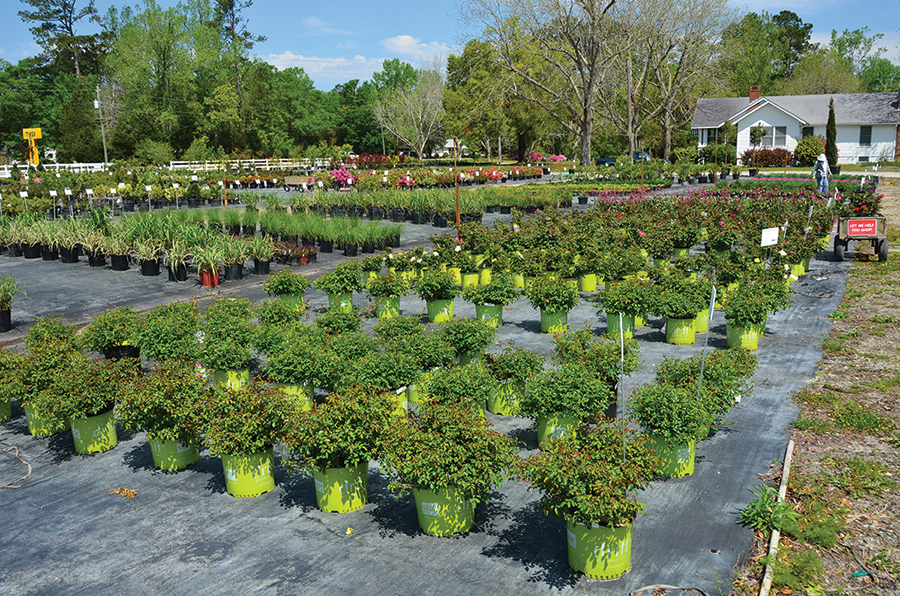How one pioneering Dutch family has kept us in bloom for a century
By Jamie Penn
Just few miles down Castle Hayne Road will lead you to Tinga Nursery, a family nursery and plant wholesaler that’s been in operation for over 100 years. How they got here and how they’ve stayed — propagating plants and flowers that keep us neck-deep in pink azaleas this time of year — begins in Holland, but is an American tale.
Eelco Idzard Tinga, circa 1906 — straight out of flower country in Holland and hungry for the American dream — happened on the scene in the U.S. just as Hugh McRae began waving the flag of hope and prosperity for emigrant farmers from what he fancied would soon be truck farming colonies. This, coupled with a blight-induced ban on all Holland bulb shipments in the 1920s, opened ample opportunity for Dutch bulb and flower farmers to gain a firm foothold in southeastern North Carolina.
The budding horticulturalist established Tinga Nursery just outside Wilmington in 1913, at the right place and the right time. But, no matter how devoted and fortunate the founder of a company, businesses rely on future generations to keeping it flourishing. What’s the secret formula to Tinga Nursery’s sustained success?
One hundred and four years after the nursery’s inception and four Eelcos later, Eelco III — known as E3 — can’t really put his finger on it.
“It’s just what I do. It’s what I’ve always done . . . I guess it just keeps going until it doesn’t anymore,” says E3, with pragmatic clarity. “Things have definitely changed, but people still need plants and we really like to grow them. We’ve got our system down. So, it works.”
Eelco Jr. asserts very linear reasoning — “It’s just in our blood.”
And it might be in their names.
Each generation of Tingas for the last five generations (including the current one) have had an Eelco in the mix. An uncommon name to begin with, the Dutch name was first given to their predecessor. And of all of the Tinga children, the sons who carried the Eelco name were the ones to plant themselves firmly in the family business long-term (Herrick Tinga was also a staple at the nursery for many years). E3 is a horticulturist, as is Eelco Jr., as was Eelco Sr., and so on.
“One thing you can count on in the nursery business is that you never get bored,” says E3, letting the smile — that supposedly all the Eelcos share — broaden over his face.
Could it be an etymological phenomenon? Eelco: “the man who seeks; master of himself; a man of balanced character” — all of which seem to define the three Eelcos that I’ve had the pleasure to meet.
Home is Where the Garden Is
The Tinga Nursery sits on 35 acres. It was here that E3 drove a tractor at age 8 and then zipped around in an old checker cab at the ripe age of 9 because his grandmother Mary Tinga, said it was about time. E3 worked alongside his dad in the potting shed, pruned plants in plastic-covered greenhouses, and dealt with customers when he could barely see over the counter. His grandmother would show up in class occasionally at Wrightsboro Elementary School less than a half a mile away to show his classmates how to spin wool. And, his grandfather would pot and prune plants behind the office where E3 later served as foreman well into his 80s.
The original Eelco Tinga had quite a different story.
Brought up in a family of bankers, he was actually the maverick in his family, starting a tradition all his own. He began spreading his wings in late 19th century Holland, when he decided to follow his passion. He studied horticulture in college and became a trained nurseryman in one of the most ideal places on Earth to learn the trade. He was a traveler early on, said Eelco Jr., visiting the U.S. several times before he landed here permanently.
“My grandfather,” says Eelco, Jr. “was 100 percent American. He was extremely proud to be here. And, he worked hard to be as American as possible.”
While a Dutch accent is a great sales tool in the plant business, the original Eelco would have none of it.
“He trained himself to have a perfect American accent,” remembers Eelco Jr.
Eelco Idzard Tinga chose to phase out his very obviously Dutch middle name when Eelco Sr. was born, giving him the classic American middle name of Henry. With that, the Eelco Henry Tinga tradition began. And, it’s still going. Eelco H. Tinga IV is now 15 years old. His father, E3, his mother, Melissa, his brother Fisher and he live in their late Uncle John Tinga’s house, about a 30-second walk from the family nursery across the street.
They’ve All Come to Look for America
When Eelco I. Tinga landed on Long Island in 1906, he obtained work in a rose nursery. He met Hugo Van Nes, also Dutch, and they began dreaming together. Shortly after the two took notice of fliers that littered the port advertising Hugh McRae’s 10-acre plots available to Dutch settlers, they set off in search of the American Dream they had come for.
In an unexpected partnership, Hugh McRae — businessman, conservative capitalist, and land owner in Wilmington, N.C.— and Frederick Van Eeden a Dutch Utopian philosopher and socialist — started building and promoting emigrant colonies intended to be self-sustaining communities. Together, McCrae and Van Eeden painted a picture that Dutch settlers flocked to.
Tinga and Van Nes arrived in 1908, having purchased two 10-acre plots in what is now known as the Castle Hayne loop.
Of the six colonies created by McCrae and Van Eeden, Castle Hayne was undoubtedly the most successful. “That area’s actually really good for flowers. The soil’s fairly sandy up there. Good drainage” explains Eelco Jr..
While diversity was key early on, Van Nes and Tinga were horticulturalists, and bulbs and plants became their focus.
But, much to Van Eeden and McRae’s dismay, a Utopian society was not born, nor did trucks overflow with shipments of produce. The farmers who succeeded were those who chose to cater to the dairy demand and others who grew bulbs for flowers that were suddenly a priority in the early ’20s when a blight swept the old country.
Three of the six colonies farthest from town failed, and while the farmers in successful colonies like Castle Hayne inevitably offered support to one another when necessary, it became each man and each family for themselves fairly quickly.
Van Nes bought out Eelco Tinga in 1913 shortly after Van Nes met the woman he would marry. So, Tinga strategically headed toward town, settling on two 10-acre plots in what is now Wrightsboro, just a few miles from downtown Wilmington. There, he established Tinga Nursery and Truck Farm.
In the beginning, Tinga hunkered down at night in a nearby boarding house, walking a quarter-mile or so to the land before the sun came up to tend the farm and eventually build the Craftsman-style bungalow that his 90-year-old daughter-in-law, Mary Tinga, still lives in today. Tinga had a large garden, a few crops, a cow and chickens to help feed his family (his wife, Tijitske, known as “Jesse,” and their three boys) and to contribute to truck shipments.
Tinga immediately dove into the bulb and flower business. Daffodils, gladiolas, Dutch Iris and peonies soon speckled the landscape. Other Dutch farmers followed suit and McCrae’s three thriving colonies quickly became known as “Flower Country” across the U.S.

Tried, True and Something New
So much on the Tingas’ 35 acres is the same. The bungalow, the wash house in the back, the hay barn, the bulb barn and Louie’s room (a small structure behind the main house last occupied by Louie Cantrella, a Dutch foreman sponsored by Tinga in 1924) are all products of the original Eelco. The house is on the National Register of Historic Places, and nearly everything else on the property has been designated historic by the Historic Wilmington Foundation. The structures have hardly been touched aside from the occasional rotten wood replacement and interior updates. The big church bell that used to call men in from the field to help a customer or little ones in for meals by their grandmother sits on its side against the bulb barn still shining in memories.
Young live oaks, glossy-leaved camellias, wispy wisteria and bright strokes of perennials still hail from their plastic pots in neat rows (and have since the ’50s); and greenhouses and shade houses continue to line the landscape.
Yes, such longevity, and preservation could be attributed to proverbial Dutch pragmatism and frugality, but it could also just be because it works and has always worked.
“We grow the plants our customers want, and we always have,” says Eelco Jr.
Most of what Tinga Nursery sells and has always sold, since its inception in 1913, begins on-site. The Tingas propagate at least 80 percent of the plants, flowers and trees they carry.
Aside from dropping the landscaping arm of the business, and jumping out and back into the retail business, what customers want is the biggest change the nursery has encountered. Eelco H. Tinga Sr. eliminated bulb production and transitioned to nursery plants.
“People sort of stopped gardening. We’re all just too busy now. So, someone’s doing it for them, and those guys generally come in and buy a lot of a small selection,” says Eelco Jr.. So, instead of carrying dozens of varieties of azaleas for the savvy Southern garden, they now carry less varieties, but sell just as many.
But for those few home-gardening stragglers, weekend gardeners or specialty shops, the Tingas grow and serve to suit. Now the Tingas are developing their own varietals and custom grow rare and sought-after plants like the mother vine, a scuppernong grape vine discovered by the first explorers in 1584 on Roanoke Island, specialty blueberries and hard-to-find flowering shrubs.
And it’s this kind of service, says E3, that keeps customers coming back.
“We do some shipping, but most of our customers are local, and have been with us for a really long time. They know what to expect when they come here. They know they can get what they want and that we know what we’re talking about,” he said.
“That’s right,” said Eelco Jr. “By now, we ought to know, I guess.” Cue that Eelco Tinga smile.
Jamie Penn is a writer, mother of three. The more she discovers and uncovers historically, culturally, and otherwise about the area, the more she falls in love with calling it home.


